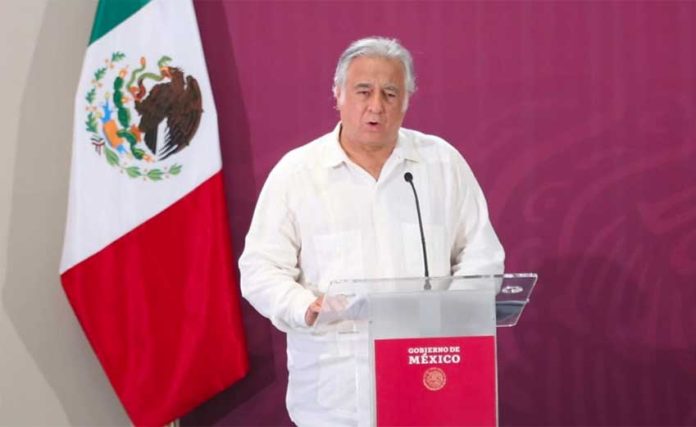The federal government presented a six-year tourism strategy yesterday with five key goals, including construction of the Maya Train, increasing foreign visitors’ spending and strengthening the sector across Mexico.
Speaking at an event in Chetumal, Quintana Roo, President López Obrador said tourism contributed US $22 billion to the economy last year, making it Mexico’s third biggest foreign exchange earner behind the automotive sector and remittances by Mexicans working outside the country.
“That’s why it’s very important for us to maintain economic growth and continue creating jobs in the sector. We’re going to implement a plan to grow the whole country but we want to support tourism and at the same time support regions that are lagging behind in terms of growth, employment and well-being . . .” he said.
The tendering process for the Maya Train, a rail project that will connect cities in Mexico’s southeast, will begin soon, López Obrador said.
“I’m very happy that the Maya Train is being well accepted, that will help a lot. It’s a very important infrastructure project. We’re going to build it with the participation of the public sector, the private sector and the social sector. It’s an investment of around 120 billion pesos [US $6.3 billion],” he said.
The president pledged that the government will do all it can to enable investors to put their money into tourism-oriented projects “without bureaucracy, without corruption [and] without bribes.”
López Obrador also announced that the government will invest 600 million pesos to improve living conditions for tourism workers in Playa del Carmen, while future investments will be made in destinations such as Acapulco, Los Cabos and Puerto Vallarta.
He said that the secretariats of Security (SSPC), National Defense (Sedena), the Navy (Semar) and Tourism (Sectur) are working together to combat insecurity in tourism destinations, stressing that the safety of visitors is paramount in order for the sector to perform well.
In turn, federal Tourism Secretary Miguel Torruco said the goal of the new tourism strategy is to position Mexico – the world’s sixth most visited country – as a competitive and forward-thinking power in the sector.
Tourism can be a means of achieving “fair and balanced development among communities and regions,” he added.
In addition to strengthening the economy and development in Mexico’s southeast through the construction of the Maya Train, Torruco said the strategy aims to increase tourism earnings, develop less-visited destinations, stimulate domestic tourism and ensure that federal, state and municipal governments work together to develop the sector.
“We have to remember that the harsh reality is that we’re in 15th place for [tourism] foreign exchange earnings and 40th for spending per capita,” he said.
Torruco criticized both the Felipe Calderón and Enrique Peña Nieto governments for not achieving better rankings in both areas despite investing billions of pesos in the Tourism Promotion Council (CPTM), which the current administration has disbanded.
To capture more tourist dollars, the government will increase its focus on attracting tourists from wealthy countries such as the United Arab Emirates, Japan, France, Italy, the United Kingdom and Korea.
Mexico’s embassies and consulates in such countries will be responsible for promoting tourism through a program to be known as Operación Toca Puertas (Operation Door-knocking), Torruco said.
The tourism secretary also said the government will launch a program called Disfruta México (Enjoy Mexico) to stimulate domestic tourism.
The program builds on the Viajemos Todos Por México (Let’s All Travel Through Mexico) initiative implemented by the previous government and will entail entering into agreements with tour operators in order to offer low-cost holiday packages to Mexicans.
A pilot program known as Sonrisas por México (Smiles for Mexico) will offer low-income Mexicans the chance to travel free, Torruco said, pledging that “tourism will be a right for all.”
The government will also strengthen its capacity to capture tourism-related statistics such as hotel occupancy rates and museum visitor numbers.
Furthermore, Torruco said that Sectur is currently working with the Secretariat of Finance (SHCP) to regulate online accommodation platforms such as Airbnb.
New taxes are expected to be imposed on online booking platforms with the resources collected to be used for tourism promotion.
A record 41.4 million international tourists came to Mexico last year, 5.5% more than in 2017, and they spent more while they were in the country.
The Tourism Secretariat expects international tourism to continue to grow this year but statistics that show that international arrivals to Cancún declined last month, a cause for concern because the resort city is seen as a barometer of the overall tourism situation in the country.
Cancún and the Riviera Maya, along with Mexico City, account for 62% of all international tourism in Mexico, Torruco said, stressing that greater diversification of the sector is needed.
Source: El Economista (sp), Notimex (sp), Milenio (sp)
